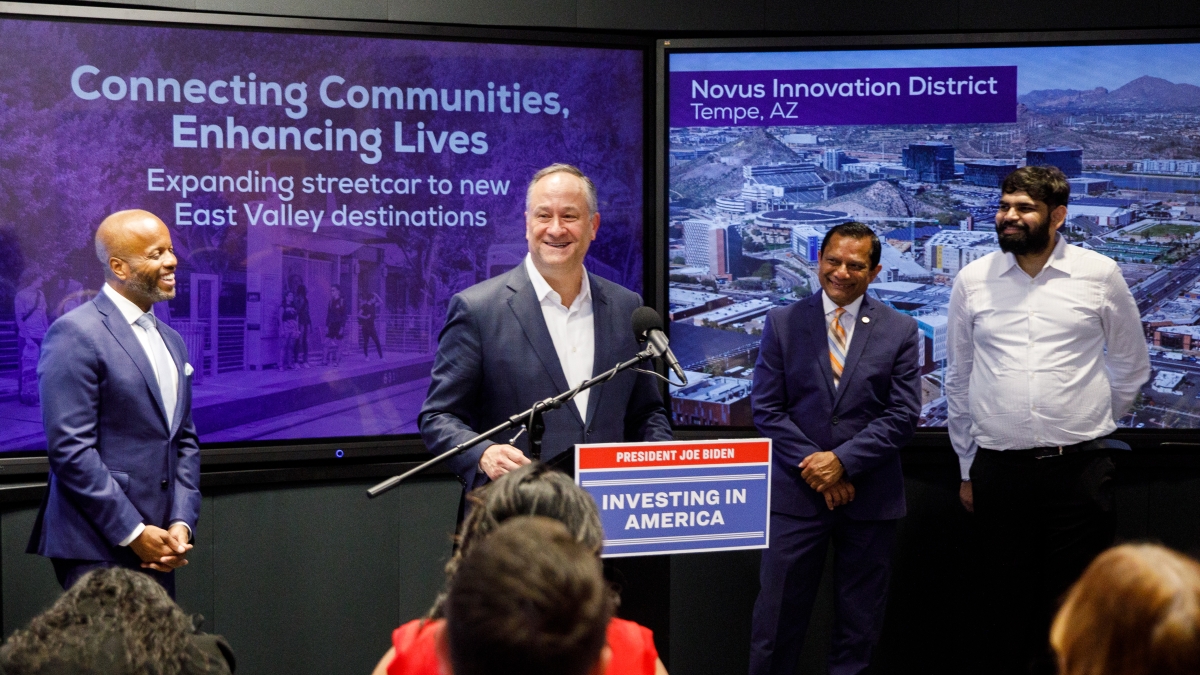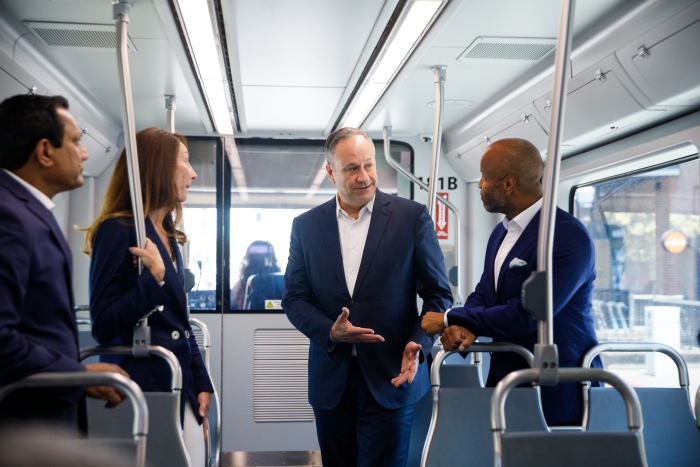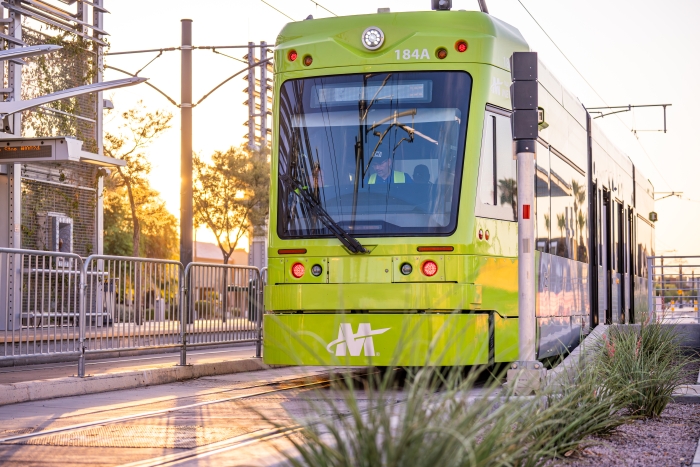Federal, state officials gather at ASU to celebrate $15.9M in federal funding for Tempe–Mesa streetcar expansion

Second gentleman Douglas Emhoff speaks at a press conference Friday, July 19, at Decision Theater in Tempe, Arizona. Photo by Andy DeLisle/ASU Knowledge Enterprise
Surrounded by the seven brightly illuminated screens of Arizona State University’s Decision Theater drum — a multipurpose collaboration space that can be deployed to assist decision-makers and stakeholders in designing implementable scenarios — second gentleman Douglas Emhoff joined Arizona officials and ASU community members on July 19 to celebrate a crucial federal investment into sustainable public transportation in the ever-growing East Valley.
The event was to discuss a recent $15.9 million federal grant to Valley Metro that will support exploring the expansion of the Tempe streetcar into Mesa. The funding will advance Valley Metro’s Rio East-Dobson Streetcar Extension (REDE) Study into the engineering and environmental phases — an effort that will eventually support East Valley residents and ASU community members alike.
“Our advocacy of transit has brought jobs, businesses and investment to our city,” said Tempe Mayor Corey Woods. “Our streetcar route has been very attractive to developers of all kinds, especially those who want to provide student and workforce housing.”
Emhoff, who came to ASU to discuss the recent funding and priorities of the Biden-Harris administration, said Maricopa County as a whole has been greatly left behind by infrastructure development. The Biden-Harris administration seeks to support communities like those in Maricopa County through Rebuilding American Infrastructure with Sustainability and Equity (RAISE) grants — such as the one secured by Valley Metro — aimed at boosting infrastructure across the U.S.
“The cities of Tempe and Mesa are experiencing rapid growth and rapid urbanization,” Emhoff said. “This has led to increased traffic congestion, pollution, residential areas and lack of transportation access to supermarkets, jobs and health care clinics.”
“President Biden and Vice President Harris understand how important it is for everyone to have access to reliable public transportation,” he said.
Expanding transportation options in the ASU community
Whether it be through its chirping noises as it navigates through Mill Avenue or its hard-to-miss green color, the Tempe streetcar has become a well-recognized character in the ASU community. Its symbiotic relationship with ASU made Decision Theater, the campus’ decision support facility, a natural gathering place to discuss the recent funding. The Decision Theater organizes researchers, policymakers and the business community to better understand and explore solutions to complex issues facing society.
While an extension of the streetcar would have a lasting impact on the East Valley community and workforce, ASU students in particular are expected to benefit. According to data from the city of Tempe, younger people are the primary users of the streetcar: Sixty-two percent of ridership is under 25, and 75% are currently in college.
Bhishma Rakeshbhai Dave, a recent ASU graduate, said the streetcar offers a convenient, safe mode of transportation for students and other transit users like himself. He said he used the streetcar to go to and from ASU, to get groceries and run other local errands.
“It has all been a great experience to use the streetcar here, and I know it is going to be in Mesa as well,” Dave said.
The proposed streetcar expansion route would offer ASU students and other Valley riders access to more destinations, such as ASU’s Novus Innovation Corridor, Tempe Marketplace, Mesa Riverview shopping center, Sloan Park — home to the Chicago Cubs baseball team during the spring training season — and Mesa’s Asian District.
According to Valley Metro, the REDE Study has continuously engaged community members for feedback and aims to provide a detailed analysis of how the streetcar can most effectively operate along the expanded route, which will more than double the existing streetcar track. At the conclusion of the study, a final recommendation to Mesa and Tempe officials will be submitted. The recommendations could be adopted as early as 2025.
'Leveling the playing field' while supporting planetary health
The Federal Transportation Administration's Region IX Administrator Ray Tellis also joined the event on July 19. He said the expansion of the streetcar will provide valuable amenities to those who reside and work in Tempe and Mesa.
Tellis said that a reliable public transportation system that expands to shopping centers, health care facilities and places of employment can be a game changer for those who do not have access to a vehicle. It also comes with a more sustainably minded benefit: Public transportation has been known to reduce fuel dependency.
“Public transportation is what levels the playing field,” he said. “Like all transit projects, it's also going to reduce congestion and, certainly, greenhouse gas emissions.”
Mesa Vice Mayor and Valley Metro Rail Board Chair Francisco Heredia said the continuation of Valley Metro’s expansion study will be of great value to Mesa residents.
“The streetcar is a key piece of the Valley's growing regional transportation network and an investment in a sustainable, more connected region,” Heredia said. “Our area has seen significant population growth in recent decades, and by expanding our transportation network, we support continued growth.”
More University news

ASU graduates overjoyed — and employed
Adam Wiechman will soon be headed to the Big Apple. Grace Reiter will be pulling up roots in May and moving to Ann Arbor, Michigan. Omkaar Shenoy is Philly bound. And Blake Niemann will be building…

ASU community exceeds goal, raises $835K for Valley of the Sun United Way
The Arizona State University community stepped up and raised over $835,266 for the Valley of the Sun United Way — exceeding the $800,000 goal for 2024.Of the total, $802,192.17 was raised through…

ASU launches online ocean futures undergraduate degrees
Our oceans make up three quarters of the planet’s surface and contain most of its biodiversity. Due to rapid and global changes, they are endangered — making more urgent a deeper knowledge of ocean…



